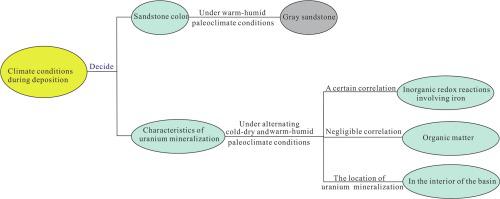当前位置:
X-MOL 学术
›
Ore Geol. Rev.
›
论文详情
Our official English website, www.x-mol.net, welcomes your feedback! (Note: you will need to create a separate account there.)
Genesis of gray sandstone within the red beds in HLJ uranium deposit, southwest Songliao Basin and its relationship with uranium mineralization
Ore Geology Reviews ( IF 3.3 ) Pub Date : 2024-04-16 , DOI: 10.1016/j.oregeorev.2024.106035 Wenjian Jiang , Mingkuan Qin , Wenkai Wang , Shaohua Huang
Ore Geology Reviews ( IF 3.3 ) Pub Date : 2024-04-16 , DOI: 10.1016/j.oregeorev.2024.106035 Wenjian Jiang , Mingkuan Qin , Wenkai Wang , Shaohua Huang

|
The search for uranium deposits in the red beds is currently a hotspot in China's sandstone-type uranium exploration efforts. The typical occurrence of uranium deposits is within gray sandstone layers amidst the red beds, where the distribution of these gray sand bodies dictates the presence of uranium deposits. Hence, delving into the genesis of gray sandstone within the red beds proves beneficial for both uranium exploration and unraveling the ore-forming mechanisms. However, there is currently significant controversy surrounding the genesis of gray sandstone in the red beds. This paper focuses on the typical uranium deposit in the red beds—the HLJ uranium deposit in the southwestern part of the Songliao Basin. It investigates the genesis of gray sandstone within uranium-bearing rock series and its relationship with uranium mineralization. The lithology of representative drill cores, including the red sandstone for comparative study, is methodically examined, along with their elemental geochemistry as well as carbon and oxygen isotope characteristics. The petrological characteristics suggest that both the gray and red sandstone share similar compositions of clastic particles, indicating minimal influence of the source rock on the sandstone color. The gray sandstone displays comparable TOC content (averaging around 0.05 %) and δO values (averaging around −16 ‰) to the red sandstone. However, it exhibits relatively higher δC values (averaging −0.26 ‰), whereas the average δC value for the red beds is −1.61 ‰. The data indicate that the gray sandstone is less affected by hydrothermal or hydrocarbon fluids. Compared to the red sandstone, which has relatively higher Cu/Al values (averaging 1.09) and Fe/Fe ratios (averaging 3.37), the gray sandstone exhibits low Cu/Al values (averaging 0.44) and a low Fe/Fe ratio (averaging 0.36), suggesting its formation in a relatively reducing environment. The reducing conditions necessary for the formation of gray sandstone may stem from the climate becoming relatively warm and humid, irrespective of whether it originates from the original sedimentary environment or is induced by the reducing pore water discharged from dark mudstones. The chemical weathering index of fine-grained sediments indicates that, the gray sandstones were commonly configured in relatively humid-warm climate with fairly low dissolved oxygen content in the bottom water. Additionally, the deposition of the uranium-bearing rock series experienced alternating climatic changes, rather than consistently being in a humid-warm climate. This resulted in the sand bodies with low TOC content, insufficient reducing potential, and uranium mineralization primarily occurring in the interior of the basin. Organic matter has a relatively weak control over uranium mineralization, whereas uranium mineralization shows a certain correlation with iron reduction. The ore-forming fluid was uranium-rich oxygenated atmospheric water. Dark-colored mudstones, formed under humid-warm climatic condition, contain relatively high TOC contents (avg. 0.43 %) and exhibit a strong reducing capacity. The reducing pore water in dark-colored mudstones excreted into the adjacent sandstones under compaction during the early diagenesis, is able to serve as a vital reducing agent in later-stage uranium mineralization. Additionally, certain dark-colored mudstones with high uranium content (up to 944 ppm) undergo significant uranium pre-enrichment, providing a partial uranium source for uranium mineralization.
中文翻译:

松辽盆地西南部HLJ铀矿床红层内灰色砂岩成因及其与铀成矿的关系
红层铀矿床寻找是目前我国砂岩型铀矿勘探的热点。铀矿床的典型产状是在红层中的灰色砂岩层内,这些灰色砂体的分布决定了铀矿床的存在。因此,深入研究红层内灰色砂岩的成因对于铀矿勘探和揭示成矿机制都是有益的。然而,目前关于红层中灰色砂岩的成因存在重大争议。本文重点研究了松辽盆地西南部典型的红层铀矿床——HLJ铀矿床。它研究了含铀岩系中灰色砂岩的成因及其与铀矿化的关系。系统地检查了代表性钻芯的岩性,包括用于比较研究的红砂岩,及其元素地球化学以及碳和氧同位素特征。岩石学特征表明,灰色和红色砂岩的碎屑颗粒成分相似,表明烃源岩对砂岩颜色的影响很小。灰色砂岩的 TOC 含量(平均约为 0.05%)和 δO 值(平均约为 -16‰)与红砂岩相当。然而,它表现出相对较高的 δ13C 值(平均-0.26‰),而红层的平均 δ13C 值为-1.61‰。数据表明,灰色砂岩受热液或烃类流体的影响较小。与红砂岩相对较高的 Cu/Al 值(平均 1.09)和 Fe/Fe 比(平均 3.37)相比,灰砂岩表现出较低的 Cu/Al 值(平均 0.44)和较低的 Fe/Fe 比(平均 3.37)。 0.36),表明它是在相对还原的环境中形成的。灰色砂岩形成所需的还原条件,无论是源于原始沉积环境还是暗色泥岩排出的还原孔隙水所致,都可能源于气候变得相对温暖和湿润。细粒沉积物化学风化指数表明,灰色砂岩普遍构造于相对湿润温暖的气候,底水中溶解氧含量较低。此外,含铀岩系的沉积经历了交替的气候变化,而不是始终处于湿润温暖的气候中。导致砂体TOC含量低,还原潜力不足,铀矿化主要发生在盆地内部。有机质对铀矿化的控制作用较弱,而铀矿化与铁的还原表现出一定的相关性。成矿流体为富铀含氧大气水。深色泥岩,湿热气候条件下形成,TOC含量较高(平均0.43%),具有较强的还原能力。早期成岩过程中,深色泥岩中的还原性孔隙水在压实作用下排泄到邻近砂岩中,可作为后期铀矿化的重要还原剂。此外,某些铀含量高(高达944 ppm)的深色泥岩经历了显着的铀预富集,为铀矿化提供了部分铀源。
更新日期:2024-04-16
中文翻译:

松辽盆地西南部HLJ铀矿床红层内灰色砂岩成因及其与铀成矿的关系
红层铀矿床寻找是目前我国砂岩型铀矿勘探的热点。铀矿床的典型产状是在红层中的灰色砂岩层内,这些灰色砂体的分布决定了铀矿床的存在。因此,深入研究红层内灰色砂岩的成因对于铀矿勘探和揭示成矿机制都是有益的。然而,目前关于红层中灰色砂岩的成因存在重大争议。本文重点研究了松辽盆地西南部典型的红层铀矿床——HLJ铀矿床。它研究了含铀岩系中灰色砂岩的成因及其与铀矿化的关系。系统地检查了代表性钻芯的岩性,包括用于比较研究的红砂岩,及其元素地球化学以及碳和氧同位素特征。岩石学特征表明,灰色和红色砂岩的碎屑颗粒成分相似,表明烃源岩对砂岩颜色的影响很小。灰色砂岩的 TOC 含量(平均约为 0.05%)和 δO 值(平均约为 -16‰)与红砂岩相当。然而,它表现出相对较高的 δ13C 值(平均-0.26‰),而红层的平均 δ13C 值为-1.61‰。数据表明,灰色砂岩受热液或烃类流体的影响较小。与红砂岩相对较高的 Cu/Al 值(平均 1.09)和 Fe/Fe 比(平均 3.37)相比,灰砂岩表现出较低的 Cu/Al 值(平均 0.44)和较低的 Fe/Fe 比(平均 3.37)。 0.36),表明它是在相对还原的环境中形成的。灰色砂岩形成所需的还原条件,无论是源于原始沉积环境还是暗色泥岩排出的还原孔隙水所致,都可能源于气候变得相对温暖和湿润。细粒沉积物化学风化指数表明,灰色砂岩普遍构造于相对湿润温暖的气候,底水中溶解氧含量较低。此外,含铀岩系的沉积经历了交替的气候变化,而不是始终处于湿润温暖的气候中。导致砂体TOC含量低,还原潜力不足,铀矿化主要发生在盆地内部。有机质对铀矿化的控制作用较弱,而铀矿化与铁的还原表现出一定的相关性。成矿流体为富铀含氧大气水。深色泥岩,湿热气候条件下形成,TOC含量较高(平均0.43%),具有较强的还原能力。早期成岩过程中,深色泥岩中的还原性孔隙水在压实作用下排泄到邻近砂岩中,可作为后期铀矿化的重要还原剂。此外,某些铀含量高(高达944 ppm)的深色泥岩经历了显着的铀预富集,为铀矿化提供了部分铀源。



























 京公网安备 11010802027423号
京公网安备 11010802027423号